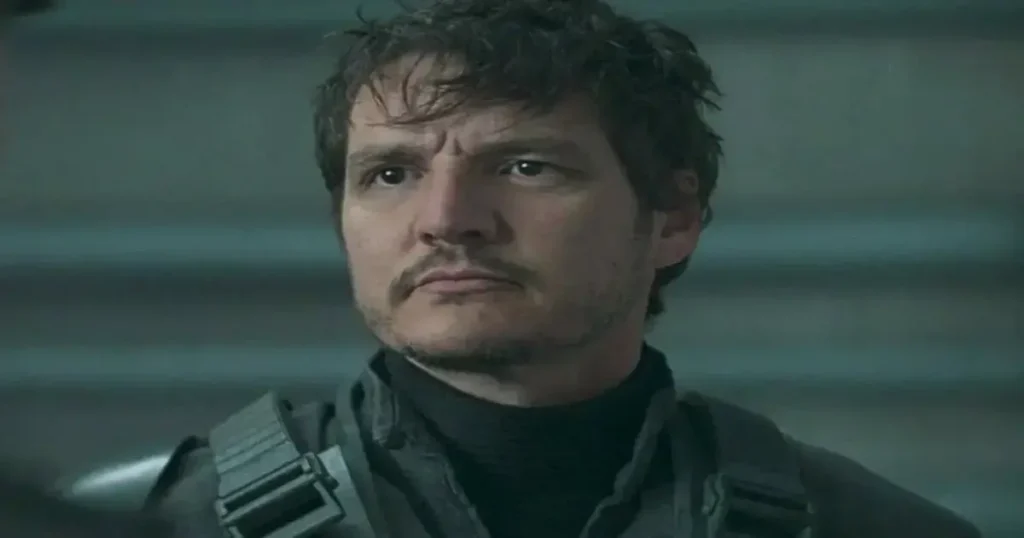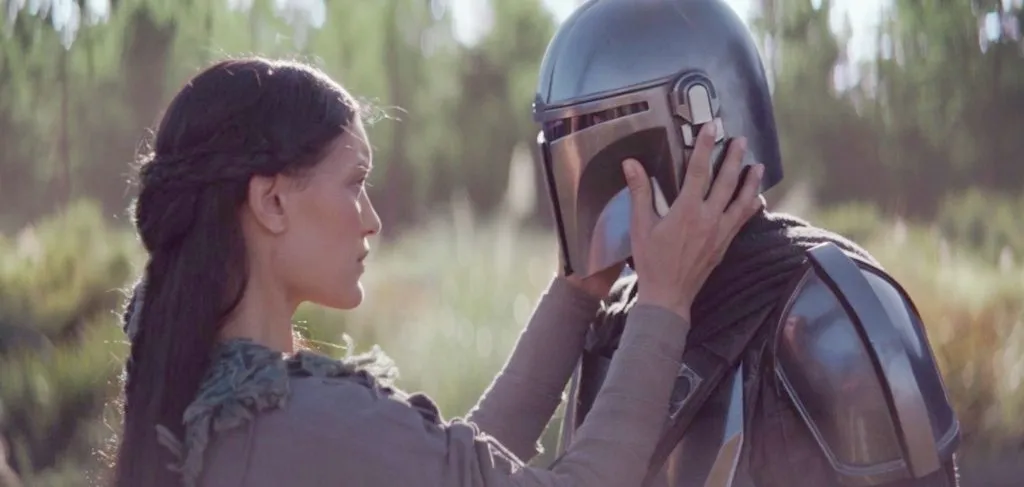The Mandalorian, the stoic bounty hunter protagonist of the hit Disney+ Star Wars series, is almost always seen wearing his distinctive Beskar armor and helmet. However, in key moments during the show, he removes his helmet – an act forbidden by the Mandalorian creed.
Why does he break this sacred rule? There are deeper reasons related to the character’s history, motivations, and connections to others. In this article, we’ll explore:
- The significance of helmets in Mandalorian culture
- When and why the Mandalorian removes his helmet
- The consequences of him breaking the sacred creed
- How removing his helmet evolves his character
- Connections to his past and future
- Fan theories about the meanings behind his unmasking
Understanding the importance of the Mandalorian’s helmet and the meaning of its removal provides insight into this complex character and Star Wars lore.
The Significance of Helmets in Mandalorian Culture

The Helmet Rule in Mandalorian Culture
- Sacred creed tied to their identity and way of life
- By law, must never be removed in front of others
- Hides identity and provides combat advantages
- Sign of religious devotion and solidarity
Reasons For the Helmet Rule
- Obscures individual identity for communal culture
- Inspires fear and mystery as an elite warrior
- Hides weaknesses, emotions, humanity
- Technological aids like heads-up display and targeting
- Protection in combat
What the Helmet Means to Mandalorians
- Honor – Wearing it brings honor to their people
- Faith – It shows devotion to “the Way”
- Discipline – Never removing it demonstrates extreme self-control
- Security – Anonymity provides safety for themselves and clan
- Superiority – Represent their skills and principles as warriors
So for the Mando, removing his helmet carries huge cultural, social, and spiritual significance. But in pivotal scenes, he makes the choice to unmask himself.
When and Why Did the Mandalorian Remove His Helmet?

The Mandalorian goes helmetless on a few key occasions in the series for important reasons related to character development and plot progression:
To Save Grogu from the Stormtroopers
- Removes helmet to connect with Grogu emotionally and gain his trust
- Necessary to get Grogu to use his Force powers to defeat enemies
- Prioritizes saving Grogu over adhering to the Creed
To Say Goodbye to Grogu
- Removes helmet to make an emotional connection with Grogu
- Allowed Grogu to see his face one last time before letting him go
- Places his personal feelings above Mando code
To Accept the Darksaber from Bo-Katan
- Removes helmet to be “visible” when taking on leadership role
- Symbolic of being open and accountable to others under his rule
- Signals he is no longer just a lone bounty hunter
To Say Goodbye to Grogu Again
- Removes helmet to have an unobstructed final moment with his “son”
- No longer hides his identity, emotions, or humanity from Grogu
- Cares more about their bond than “the Way”
In all cases, the reasons relate to forming personal connections and showing his face as a symbolic unmasking of his humanity – huge steps for his reserved character.
Consequences of Him Breaking the Sacred Creed
When the Mando removes his helmet, it has significant consequences:
- He can never put the helmet back on, by Mando law
- Becomes culturally exiled from his fellow Mandalorians
- Loses the anonymity and prestige of being a faceless Mando
- Is permanently unmasked and exposed emotionally and physically
- Surrenders a degree of power and mystique as a feared bounty hunter
- Opens himself up to new attacks or manipulations without mask
- Invites scorn from some Mandalorians for breaking tradition
However, he willingly accepts these consequences in order to build bonds with those he cares about – particularly Grogu – and shift into a leadership role as a more open and visible protector.
How Removing His Helmet Evolves the Mandalorian’s Character
The Mandalorian’s choice to remove his helmet demonstrates huge growth for his character:
- Shows willingness to accept consequences to follow his heart
- Moves from lone warrior to connected leader and father figure
- Exposes his face, emotions, and humanity
- Prioritizes personal connections over Mando code
- Reveals past pain and desire for connection after childhood isolation
- Symbolizes increased openness, accountability, and broader purpose
- Suggests he is forging his own version of “the Way”
- Sets him on a path to guide and unite Mando as leader
It required leaving behind the safety and security of the helmet. This signals a powerful shift from cold, calculating bounty hunter to more feeling and vulnerable protector and caretaker for the “tribe” he views as his new clan.
Connections to His Past and Future
The helmet removal relates deeply to the Mandalorian’s past trauma and future direction:
Link to Past Loss and Yearning for Connection
- Orphaned as a child when his parents were killed
- Rescued and raised by Mandalorians as a “foundling”
- Lost parents, home, identity, and sense of belonging
- Cold beskar helmet hid painful memories and emotions
- Removing it exposes his desire for family and connection
Looking to His Future Purpose and Destiny
- No longer just a lone bounty hunter
- Will rebuild and lead the new Mando tribe
- Forging his own interpretation of “the Way”
- Must stand visible as a leader and guide now
- Caring for Grogu helps him find meaning and purpose
- His new path requires vulnerability and connection
- Choosing connections over the Creed is his destiny
By abandoning the helmet that hid his pain and path, he opens himself up to forge new purpose, meaning and human bonds as a leader and father figure – themes that will carry through upcoming seasons.
Fan Theories About the Meanings Behind the Mandalorian’s Helmet Removal
Fans have some interesting theories about the symbolic reasons behind the Mandalorian’s distinct helmet and when he chooses to remove it:
He’s Forging His Own “Third Way”
- Not an orthodox Mandalorian traditionalist
- Nor a ruthless bounty hunter with no code
- Walking his own path in between by removing helmet for love
It Shows His Rejection of His Violent Past
- Helmet linked to bloody history as a bounty hunter
- Removing it for Grogu represents leaving that behind
It Suggests He’s the Mythic Mandalore Figure
- An ancient prophecy talks of a helmetless Mandalorian leader
- Some think this refers to the Mandalorian and his destiny
It’s About Letting Go of Trauma and Isolation
- The helmet hid pain from his childhood trauma and isolation
- Removing it finally lets him open up and connect with others
While the actual reasons are unclear, the helmet removal clearly seems symbolic of the Mandalorian entering a new phase focused on building connections, purpose and destiny.
Conclusion
For theReserved and stoic Mandalorian, removing his helmet carries deep personal, cultural and spiritual significance. It violates a sacred Mandalorian creed tradition and way of life he was raised to dutifully uphold.
However, his key decisions to unmask himself demonstrate his transformational shift from lone warrior to self-exposed leader centered on connecting with and protecting others he cares about, particularly Grogu.
This act suggests he is stepping into a larger purpose and destiny as a leader and father figure guiding the resurrection of the Mandalorian culture and creed – a new path that requires vulnerability and humanity rather than cold anonymity.
The helmet removal indicates both the Mandalorian’s traumatic past and hopeful future direction lie in forging personal connections.
Does the Mandalorian ever take off his helmet in the show?
Yes, he removes his helmet a handful of times throughout the series during emotionally pivotal moments to make connections with Grogu and others.
When does the Mandalorian first remove his helmet?
The first time he is shown without his helmet is in Chapter 8 of Season 1, when he removes it to connect with Grogu and gain his trust before the battle with the stormtroopers.
Why did the Mandalorian have to remove his helmet?
He chose to remove it in order to form emotional bonds and connections with those he cared about, particularly Grogu, even though this went against the Mandalorian creed.
Does removing his helmet go against the Mandalorians’ code?
Yes, by removing his helmet after taking the creed as a Mandalorian, he is explicitly breaking the ancient Mandalorian law and code.
What are the consequences of him removing his helmet?
By removing it, he can never put the helmet back on again, and is permanently exiled from the Mandalorian culture and way of life he was raised in.
Will he ever put his helmet back on now?
No, after removing his helmet, he can never don it again according to the sacred Mandalorian creed, even if he wanted to.
Why doesn’t he just put it back on and pretend he never removed it?
Once removed, it can never be worn again by law. Plus it carries deep cultural, spiritual and emotional significance showing he is open and exposed permanently now.
Does the helmet removal suggest a shift in the character’s path?
Yes, it signals a transformation from lone bounty hunter to connected father figure and leader guiding a new Mandalorian tribe based on his reforged interpretation of the creed.
How do fans interpret the meaning behind him removing his helmet?
Some see it as him forging his own “Third Way”, overcoming past trauma, rejecting his violent history, or embracing a mythic destiny as a prophesied leader.
